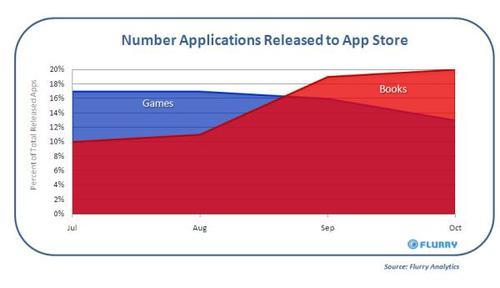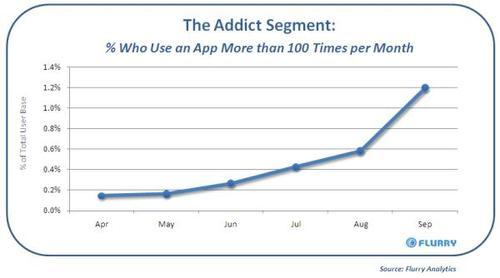The data in this report is computed from a sample size of over 2,500 applications, 40 million consumers and 4 platforms: Apple (iPhone and iPod Touch), Blackberry, JavaME and Google Android.
After Playing Games, iPhone Gets Serious about Books
The iPhone is a versatile multi-media device that has already significantly impacted the business models of music, games and other Media & Entertainment industry categories. In particular, since Apple launched the App Store in July 2008, game developers have flocked to the iPhone, creating an alternative for consumers to the leading handheld gaming platform, Nintendo DS. In Nintendo’s October 29 earnings call, the company cited iPhone competition against its DS as one of the reasons profits fell by more than half last quarter, from 133 billion yen a year prior to 64 billion yen, or $709 million.
To predict which sector of Media & Entertainment iPhone might next impact, Flurry researched the number of applications released to the App Store, by category, since its inception. From August 2008 to August 2009, more apps were released in the Games category than any other. This September, however, we observed another category, Books, usurping Games for the first time ever. To illustrate the surge in the supply of books to the App Store, the chart below compares the number of books and games released to the App Store per month, over the last four months, as a percentage of all released applications.

In October, one out of every five new apps launching in the iPhone has been a book. Publishers of all kinds, from small ones like Your Mobile Apps to mega-publishers like Softbank, are porting existing IP into the App Store at record rates. Flurry first evaluated the iPhone as an eBook reader in its July Pulse (“You Trying to Swindle my Kindle?”) where it looked at consumer demand for eBooks. In that report, we observed that during the month of August 1% of the entire U.S. population was already reading a book on the iPhone. Now, with books shipping in droves, we are seeing the supply-side explode.
The sharp rise in eBook activity on the iPhone indicates that Apple is positioned take market share from the Amazon Kindle as it did from the Nintendo DS. Despite the smaller form factor of the display, we predict that the iPhone will be a significant player in the book category of the Media & Entertainment space. Further, with Apple working on a larger tablet form factor, running on the iPhone OS, we believe Jeff Bezos and team will face significant competition.
Addicted to iPhone Apps? There’s an App for That.
In its August Pulse report, Flurry reviewed consumer loyalty by looking at how long and how frequently consumers used their downloaded applications. This time around, we’re escalating the conversation from retention to outright addiction. The chart below depicts growth of what we call the “Addict” segment, consumers that use an application more than 100 times per month, or more than three times each day of the month. These are the most active users Flurry tracks, and they fire up their applications more than 10 times more often than the average user, who access their applications around 8 times per month.

The graph above shows significant growth in the Addict segment over the past six months. In September, 1.2% of the more than 40 million users Flurry tracked, or roughly one half of a million, used apps more than 100 times per month. Unrelated to Flurry’s finding, a Rubicon Consulting survey found that one in ten iPhone users reported pain or numbness in their fingers. Perhaps there is a correlation between usage and physical side-effects. Either way, there is no denying the level of addiction iPhone users are demonstrating around app usage.